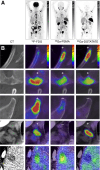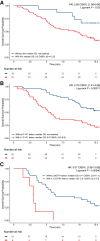Intrapatient Intermetastatic Heterogeneity Determined by Triple-Tracer PET Imaging in mCRPC Patients and Correlation to Survival: The 3TMPO Cohort Study
- PMID: 39327017
- PMCID: PMC11533914
- DOI: 10.2967/jnumed.124.268020
Intrapatient Intermetastatic Heterogeneity Determined by Triple-Tracer PET Imaging in mCRPC Patients and Correlation to Survival: The 3TMPO Cohort Study
Abstract
Intrapatient intermetastatic heterogeneity (IIH) has been demonstrated in metastatic castration-resistant prostate cancer (mCRPC) patients and is of the utmost importance for radiopharmaceutical therapy (RPT) eligibility. This study was designed to determine the prevalence of IIH and RPT eligibility in mCRPC patients through a triple-tracer PET imaging strategy. Methods: This was a multisite prospective observational study in which mCRPC patients underwent both 18F-FDG and 68Ga-prostate-specific membrane antigen (PSMA)-617 PET/CT scans. A third scan with 68Ga-DOTATATE, a potential biomarker of neuroendocrine differentiation, was performed if an 18F-FDG-positive/68Ga-PSMA-negative lesion was found. Per-tracer lesion positivity was defined as having an uptake at least 50% above that of the liver. IIH prevalence was defined as the percentage of participants having at least 2 lesions with discordant features on multitracer PET. Results: IIH was observed in 81 patients (82.7%), and at least 1 18F-FDG-positive/68Ga-PSMA-negative lesion was found in 45 patients (45.9%). Of the 37 participants who also underwent 68Ga-DOTATATE PET/CT, 6 (16.2%) had at least 1 68Ga-DOTATATE-positive lesion. In total, 12 different combinations of lesion imaging phenotypes were observed. On the basis of our prespecified criteria, 52 (53.1%) participants were determined to be eligible for PSMA RPT, but none for DOTATATE RPT. Patients with IIH had a significantly shorter median overall survival than patients without IIH (9.5 mo vs. not reached; log-rank P = 0.03; hazard ratio, 2.7; 95% CI, 1.1-6.8). Conclusion: Most mCRPC patients showed IIH, which was associated with shorter overall survival. On the basis of a triple-tracer PET approach, multiple phenotypic combinations were found. Correlation of these imaging phenotypes with genomics and treatment response will be relevant for precision medicine.
Keywords: IIH; PET; intrapatient intermetastatic heterogeneity; metastatic castration-resistant prostate cancer; molecular imaging.
© 2024 by the Society of Nuclear Medicine and Molecular Imaging.
Figures





References
-
- Gillessen S, Bossi A, Davis ID, et al. . Management of patients with advanced prostate cancer-metastatic and/or castration-resistant prostate cancer: report of the Advanced Prostate Cancer Consensus Conference (APCCC) 2022. Eur J Cancer. 2023;185:178–215. - PubMed
-
- Davies AH, Beltran H, Zoubeidi A. Cellular plasticity and the neuroendocrine phenotype in prostate cancer. Nat Rev Urol. 2018;15:271–286. - PubMed
Publication types
MeSH terms
Substances
LinkOut - more resources
Full Text Sources
Miscellaneous
